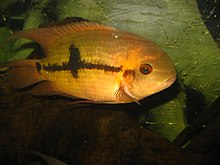| Hypselecara | |
|---|---|
 | |
| Emerald Cichlid (H. temporalis) | |
| Scientific classification | |
| Domain: | Eukaryota |
| Kingdom: | Animalia |
| Phylum: | Chordata |
| Class: | Actinopterygii |
| Order: | Cichliformes |
| Family: | Cichlidae |
| Subfamily: | Cichlinae |
| Tribe: | Heroini |
| Genus: | Hypselecara S. O. Kullander, 1986 |
| Type species | |
| Heros temporalis Günther, 1862 | |
Hypselecara is a small genus of cichlids native to the Amazon and Orinoco basins in South America. H. temporalis is a relatively common aquarium fish known in the aquarium trade as the chocolate cichild.